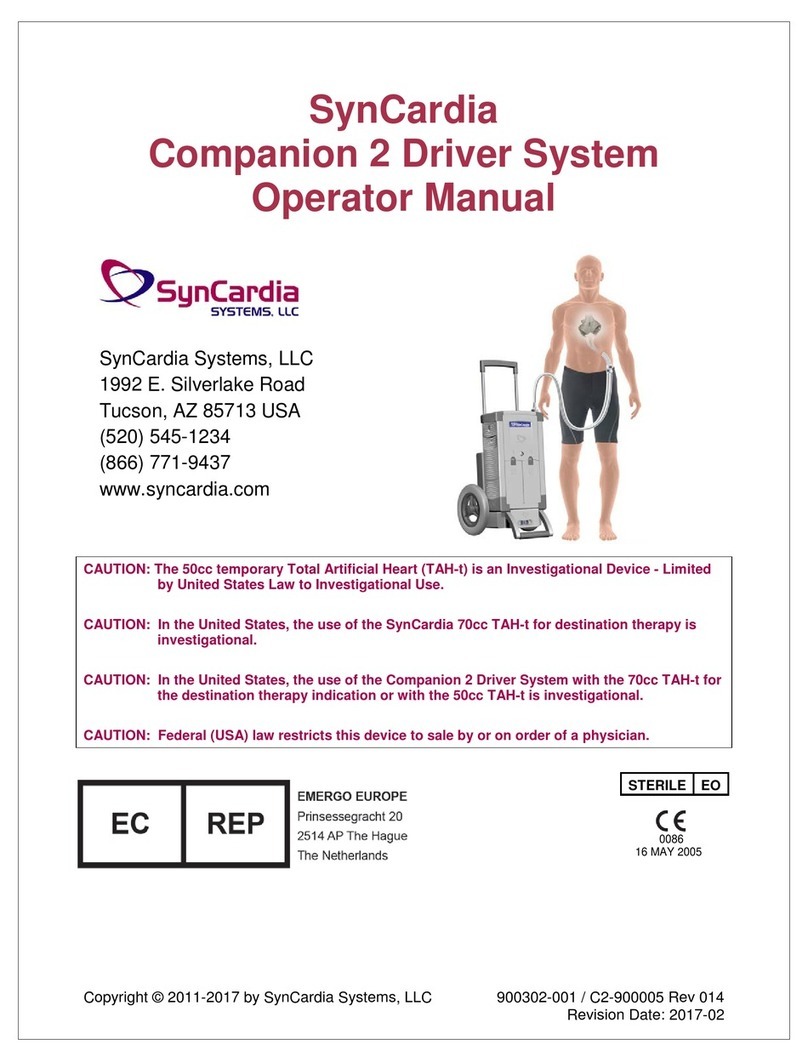
SynCardia TAH-t Instructions for Use
SynCardia Systems, Inc. Page 10
7.0 Implant Procedures
This section contains the Implant Procedures. Patients receiving the SynCardia TAH-t
are prepared for the implant per standard hospital procedures for any cardiac surgery.
An arterial line, a central line, and standard artificial ventilation are required prior to
the start of surgery. Transesophogeal echocardiography is recommended.
7.1 Materials Needed but not Provided
•Three 15 by 20 centimeter sheets of membrane are used to create a neo-
pericardium to prevent adhesions.
•Teflon felt buttresses strips. These are cut to approximately 10-12 mm
in width and are generally 10 cm in length. It most often takes at least
two of these to extend around the entire atrial cuff. (See Section 7.3)
7.2 Preparation
•Pass the SynCardia TAH-t sterile components into the sterile field.
•After a standard median sternotomy is performed and before starting
heparin, 1) prepare the arterial outflow connectors, 2) trim atrial inflow
connectors to appropriate size, and 3) tunnel the artificial ventricle
conduits through the skin.
•Preclot the two arterial outflow connectors three times with the patient's
blood before giving the heparin. After exposure to the blood (approx.
30 cc for each connector each time) stretch connector, let dry for about
5 minutes and preclot again. The connectors are coated on the outside
with biologic glue (cryoprecipitate with calcium and topical thrombin).
Stretch again and let dry. This is done before cannulation so there is
plenty of time to obtain sufficient preclotting of the outflow connectors.
If the patient has been heparinized before deciding to implant the
SynCardia TAH-t, the arterial outflow connectors should be preclotted
with a combination of heparinized blood, protamine, and thrombin.
•Trim the two inflow connectors. Cut edges of the atrial quick connects
for the atrial anastomoses to a radius extending out from the connector
for 5-7 mm. Cut in a completely circular fashion. Then stretch and
invert them.
•Pass the drivelines conduits through their subcutaneous pathways
before heparinization of the patient. Position the left-sided ventricle
conduit in the epigastrium at the level of the midclavicular line and
approximately 2 inches below the costal margin. Make a semicircular
skin flap incision on the left midclavicular line approximately 5 to 10
cm below the costal margin.
•Place a long clamp through the subcutaneous tissue, rectus fascia,
rectus muscle, and into the chest as a chest tube would be placed. Use
a similar approach to place the driveline conduit for the prosthetic right





























